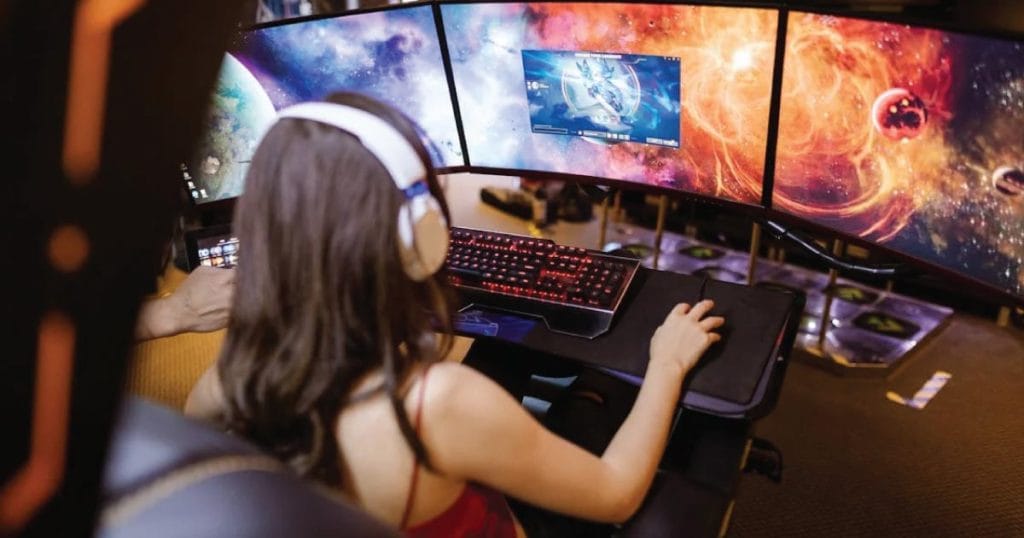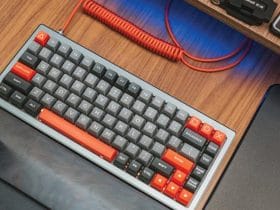Archives
Categories
Gaming Monitors: Best Options for MMOs and RPGs
Latest Posts
OUR HOT TOPICS

The Japan Next team is happy to offer its expertise to make your life easier when choosing a PC monitor that is as close as possible to your real needs. This week, in the big category of gaming monitors, we explore the best possible options between MMO and RPG for gamers.
MMO (Massively Multiplayer Online) and RPG (Role Playing Game) video games require total immersion to offer the best possible experience. To do so, choosing a quality screen is essential. Japannext examines for you the key aspects to consider when selecting the best screens for gaming, presenting a detailed comparison of resolutions and refresh rates, as well as different models to guide your choice.
Resolution: What impact does it have on the gaming experience?
A display’s resolution determines the clarity and precision of the images displayed. For MMORPGs and RPGs, where graphics play a crucial role in immersion, a high resolution allows you to fully enjoy the detailed visual content these games offer.
1080p: Full HD as the standard for MMOs and RPGs?
Many gamers still settle for 1080p resolution, also known as Full HD. Here are some of its benefits:
- More economical compared to higher resolutions.
- It offers good performance for average PC configurations.
- Sufficient level of detail for most games.
However, this resolution can show its limits in modern MMOs and RPGs that benefit from vastly improved graphics.
1440p: QHD for MMO and RPG details
Moving up to 1440p, or Quad HD, resolution significantly improves visual quality while remaining accessible for most gaming setups. Benefits include:
- Sharper images compared to 1080p.
- Interesting compromise between performance and visual quality
- Excellent for commonly available graphics cards.
This resolution is gradually becoming the new standard among gamers looking for a better experience without sacrificing too much in terms of performance.
4K: Ultra HD for gaming purists
For those seeking the ultimate immersion, 4K resolution delivers stunning images with their sharpness and clarity. Some highlights include:
- Extremely fine detail, ideal for the vast and rich landscapes of RPGs.
- Compatible with the latest graphics innovations in modern games.
- Exceptional immersion thanks to high pixel density
But beware, playing in 4K requires a high-end graphics card and high-performance settings to maintain satisfactory fps rates.
Refresh rate: fluidity above all
Refresh rate, measured in hertz (Hz), indicates how many times a screen can refresh per second. A higher rate means a smoother image, which is essential for responsive and immersive gaming experiences.
60 Hz: the bare minimum
Starting from acceptable fluidity, a 60Hz refresh rate remains the minimum threshold for decent gameplay in MMOs and RPGs. Its advantages and limitations include:
- Suitable for less powerful machines
- Adequate performance for games that don’t require extreme responsiveness.
- It can show its limits for intense action games.
Using a 60Hz display is usually sufficient for the casual gamer, but can frustrate those who are used to higher performance.
144 Hz: the perfect compromise
144Hz displays are quickly becoming the gold standard for serious gamers. Their advantages are numerous:
- Significant improvement in the fluidity of movements.
- Significant reduction in kinetic blur effects.
- Supports most current graphics cards.
This refresh rate is perfect for players involved in action-packed MMOs and RPGs that require precision in combat.
240Hz and beyond: for gaming experts
Aimed at competition and optimization enthusiasts, a 240Hz rate guarantees a fluid experience. Its main advantages include:
- Unparalleled feeling of fluidity
- Optimal response capacity during intense action phases.
- Ideal for very high-end configurations
However, these screens can be expensive and are only fully utilized with high-performance machines.
Selection of the best current gaming screens
27-inch 144Hz 4K UHD PC Gaming Monitor
Description of our gaming monitor :
- Refresh rate: 144 Hz
- Response time: 1 ms
- Panel: IPS for exceptional image quality
- Resolution: 3840×2160 4K
- HDMI 2.1: For transferring 4K signals up to 120 Hz (compatible with consoles)
- sRGB 100%
27-inch WQHD (2560×1440) 360Hz PC gaming monitor
Description of our gaming monitor, key features:
- Refresh rate: 360 Hz
- Response time: 1 ms
- Panel: IPS UltraFast for exceptional image quality
- Resolution: 2560×1440 WQHD
- sRGB 100%
- Power delivery USB-C 90w: charge your PC or MAC directly from the monitor
31.5 inch 165Hz PC Gamer Monitor
Description of our gaming monitor, key features:
- Refresh rate: 165 Hz
- Response time: 1 ms
- Panel: IPS for exceptional image quality
- Resolution: 2560×1440 WQHD
- Flicker-free: eliminate annoying screen flickering
- HDR: for an immersive experience
Analyze your needs before purchasing your gaming monitor
Choosing the best monitor depends on a number of personal and technical criteria. Evaluating your priorities, such as desired resolution, required refresh rate, and compatibility with your current system, allows you to select the ideal display to optimize your MMO and RPG experience. Each gamer will need to find a balance between graphics performance and available budget to achieve optimal immersion during their gaming sessions.
Which monitor to choose for an MMO: the complete gaming guide?
Choosing the right display for MMO (massively multiplayer online role-playing games) can transform your gaming experience. MMORPGs like World of Warcraft, The Elder Scrolls Online, or Final Fantasy XIV require highly-rated, high-performance displays to maximize immersion and performance. This guide will help you determine which type of display best suits your specific needs.
Gaming screen size: finding the middle ground
Screen size is one of the first criteria to consider when choosing a new gaming monitor for MMOs. This influences not only the immersion in the game but also the resolution and graphics performance.
24-inch vs. 27-inch displays for MMOs
- 24-inch displays offer a reasonable size for most desktop setups. They are generally affordable and easy to position. However, they may lack immersion for some gamers.
- On the other hand, 27-inch screens provide greater immersion thanks to their larger display surface. They also allow you to fully enjoy higher resolution such as 1440p (QHD), which remains a popular standard among gamers.
Ultra-wide and curved monitors
- An ultra-wide (21:9) display offers an expanded field of view, ideal for MMO games where a wider panorama can improve strategy and environmental awareness.
- Curved displays increase this immersion by slightly enveloping your peripheral vision. For open-world titles like Black Desert Online, these monitors can be particularly advantageous.
Gaming screen resolution: optimize your visuals
Your screen resolution directly influences the image quality and detail displayed in-game. Here are some common options and their respective benefits.
Full HD (1080p)
Full HD remains a common and economically viable option. For gamers with a mid-range PC setup, 1080p allows for good performance without requiring a very powerful graphics card. It’s perfect for those who prioritize fluidity.
Quad HD (1440p)
If your gaming PC is equipped with a robust graphics card, opting for a Quad HD display can offer a noticeable improvement in visuals while maintaining a high refresh rate. The 1440p finds an excellent balance between image quality and performance.
Ultra HD (4K)
Ultra HD offers exceptional pixel density, ideal for appreciating all the details of the landscapes and characters in your favourite MMOs. However, this resolution requires an extremely powerful PC configuration to ensure a smooth experience, especially in resource-intensive titles.
Refresh rate: fluidity above all
For MMO fans, a high frame rate means smoother, more responsive action. Let’s compare some common rates.
60Hz
This frequency is the minimum required for a smooth experience in virtually all video games, including MMOs. While it is adequate, many gamers are now looking for higher options.
120Hz and 144Hz
These frequencies have become popular among gamers. They offer greater fluidity that can make a big difference in intense action scenes or complex raids. A 144 Hz monitor is recommended for those who want responsive gameplay without breaking the budget.
165 Hz and above
Even higher frequencies such as 165 Hz or even 240 Hz offer extreme responsiveness. Although they are more common among competitive FPS players, they can also provide a noticeable advantage in MMORPGs with dynamic combat. However, these monitors require a high-end configuration to take advantage of their potential.
Panel technology: IPS, VA or TN?
Panel technology plays a key role in image quality, viewing angles, and response time. Each of these families has its pros and cons.
IPS panels
In-plane switching (IPS) panels are prized for their vivid, accurate colours and wide viewing angles. If you value visual quality and do a lot of graphics work outside of gaming, an IPS monitor is a smart choice.
VA panels
Vertical Alignment (VA) panels offer very good contrast and are excellent in dark environments, which can be ideal for MMOs that take place at night or underground. However, VA panels generally have slightly higher response times than IPS and TN panels.
TN Panel
Twisted Nematic (TN) panels are known for their low cost and fast response times. While they don’t match IPS in terms of image quality, they’re still a solid choice for games where responsiveness is paramount, though less useful for appreciating the beautiful environments of some MMORPGs.
Complementary options
- G-Sync/FreeSync: These technologies synchronize the refresh rate of your monitor with that of your graphics card, eliminating image tearing and offering a smoother gaming experience.
- HDR: High Dynamic Range technology increases the colour range and contrast, delivering more realistic visuals. While not all MMOs support it, it can significantly enrich those that do.
- Response Time: Look for a response time under 5ms to avoid motion blur, especially during animated battles.
- Connectivity: Make sure your monitor has HDMI, DisplayPort, and possibly USB inputs for added flexibility.
By following these tips, every MMORPG player will be able to find the perfect monitor adapted to their configuration and gaming preferences, achieving an immersive and optimal gaming experience.
What is the best resolution for RPG games?
Role-playing games, more commonly called RPGs, possess a unique technical complexity that greatly influences the gaming experience. Among these technical aspects, graphical resolution plays a crucial role. This article explores what the optimal resolutions are for playing RPGs, detailing different factors such as the size of your screen, the technology used, and the specificities of the games themselves.
Understanding Video Game Resolution
Resolution is defined by the number of pixels displayed on the screen, expressed as a pair of numbers, usually noted as width x height (e.g. 1920×1080). A higher number generally means finer, sharper visual details.
Common types of resolutions
- 720p (HD): 1280×720 pixels. Minimum acceptable baseline for modern games.
- 1080p (Full HD): 1920×1080 pixels. The current standard for most gamers.
- 1440p (Quad HD): 2560×1440 pixels. Growing in popularity thanks to a good balance between performance and quality.
- 2160p (4K Ultra HD): 3840×2160 pixels. For those looking for the best in terms of graphics.
Impact of resolution on performance
Higher resolutions place greater demands on your computing hardware. Ensuring your graphics card and processor can support these higher pixel levels is essential to avoiding frame rate drops and maintaining smooth gameplay.
Display factors: screen size and viewing distance
Screen size plays a predominant role in choosing the optimal resolution. The larger the screen, the more capable it is of displaying fine details provided the resolution is suitable. For example:
- 24-inch displays: Full HD (1080p) looks crystal clear.
- 27-inch displays: Quad HD (1440p) is recommended to maintain a high pixel density.
- 32-inch or larger displays: 4K (2160p) really starts to show its advantage.
Viewing distance also affects the perception of sharpness. If you’re sitting close to the screen, low-resolution defects will be more noticeable.
RPG Specific Considerations
RPGs often feature open worlds with rich environments and intricate details. Resolution can significantly enrich this experience in several ways.
Visual storytelling and immersion
One of RPGs’ strengths is their ability to transport players to alternate universes. High resolution allows for fine details such as clothing textures, facial expressions, and complex landscapes to be perceived. These elements enhance visual storytelling and increase immersion.
PC screen: user interface and text readability
RPG interfaces and dialogues often contain a lot of text. An inappropriate resolution can make this text blurry or illegible. Resolutions such as 1440p or 4K ensure maximum clarity but sometimes require adjusting the font size for optimal reading comfort.
Additional technology: frame rate and refresh rate
In addition to resolution, the fluidity of animations, i.e. the framerate (number of images per second), must be considered. For RPGs, where the cinematic aspect is important, a refresh rate of at least 60 Hz is recommended.
Graphics cards and compatibility.
It is advisable to pair powerful graphics cards with monitors that offer high resolutions. For example, an NVIDIA RTX 30xx series or an AMD Radeon RX 6000 series will be suitable for reaching 4K while maintaining a pleasant framerate.
Synchronization systems
The use of technologies such as G-Sync (NVIDIA) or FreeSync (AMD) improves the visual experience by avoiding tearing (image tearing) during fast movement through the RPG universe.
The balance between aesthetics and performance.
The goal is to find a balanced setting between visual fidelity and gameplay fluidity. While the temptation to optimize both resolution and graphics parameters is strong, this can lead to performance drops.
Recommended settings
- For 1080p gaming: GTX 1660 or equivalent, latest generation i5 CPU.
- For 1440p gaming: RTX 2060 or equivalent, latest generation i7 CPU.
- For 4K gaming: RTX 3080 or equivalent, latest generation i9 CPU.
Graphic parameters to adjust
- Textures: Adjust according to available VRAM.
- Shadows: Can be reduced to save performance.
- Special effects: These greatly influence the aesthetics of RPGs and should be adjusted with caution.
Personal preferences
Ultimately, choosing the right resolution depends heavily on individual gamers’ preferences. Some favour impressive graphics at any price, while others prefer to maintain unwavering fluidity, even if that requires making some visual compromises.
In the realm of RPG games, where the balance between all these elements directly contributes to the immersion and overall appreciation of the game universe, finding this perfect balance can transform the player’s personal experience.









